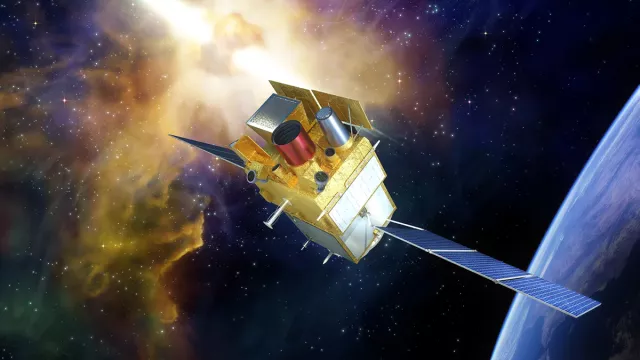SVOM is a French-Chinese astrophysics mission to detect gamma-ray bursts, the most distant star explosions in the universe.
Key information
Key figures
- 80 expected observations of gamma-ray bursts a year
- 4 instruments
- 950 kg: satellite mass
- 10 contributing French laboratories
Key milestones
- 22 June 2024: SVOM launched by Long March 2C
- March to September 2023: Environmental testing and validation of flight model
- 21 April 2023: French ECLAIRs and MXT instruments delivered to CNSA
- 11 September 2020: Critical Design Review signed off and start of phase D of development
- 8 December 2016: Start of phases CDE1 of development
- March 2007: Start of phase A of development
- 25 October 2006: CNES and CNSA initiate SVOM project
Project in brief
SVOM (Space Variable Objects Monitor) is a joint mission of the China National Space Administration (CNSA) and CNES to observe gamma-ray bursts (GRBs) from a 625-kilometre Earth orbit. GRBs are some of the highest-energy phenomena known in the universe, generated from the explosion of massive stars more than 20 times the mass of our Sun, and from the merger of binary star systems composed of compact objects like neutron stars or black holes.
The SVOM satellite is carrying four instruments, two of which were designed and built in France: ECLAIRs, a wide-field X-ray and gamma-ray camera; and MXT, a Microchannel X-ray Telescope. When ECLAIRs detects a GRB, the satellite is repointed within minutes to precisely target the event so that instruments with a narrower field of view (MXT and VT) can observe it.
Alerts are also relayed to ground in less than one minute whenever a burst is detected, indicating the location of the GRB to cue large ground telescopes.
This synergy between ground and space systems, allied to the multi-wavelength observations, is what makes the SVOM mission so special for scientists.
China is in charge of the mission, launch, satellite and operations, and shared responsibility with France for design and construction of the instruments and ground segment. The French contribution was developed in partnership with research laboratories at the IRFU research institute at CEA, the French atomic energy and alternative energies commission, and at INSU, the national institute of universe science, and IN2P3, the national institute of nuclear and particle physics, both attached to the national scientific research centre CNRS.
CNES’s role
CNES was involved in system, satellite and payload definition studies and oversaw development of the French payload (ECLAIRs and MXT), as well as the alerting system (ground VHF network) and French components of the ground segment (payload monitoring centre and scientific expertise centres).
Contacts
Project Leader
Desi RAULIN
E-mail: desi.raulin at cnes.fr
Astronomy & Astrophysics subject matter expert
Philippe LAUDET
E-mail: philippe.laudet at cnes.fr
Universe sciences subject matter expert
Olivier LA MARLE
E-mail: olivier.lamarle at cnes.fr


